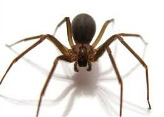Loxosceles recluse

Loxosceles reclusa is a dusky-tan or brown spider with the widest range of any recluse spider can be transported in luggage and household furnishings. The Brown Recluse is smaller than the Black Widow; it has an oval abdomen rather than a round one. The abdomen is uniformly tan to brown without marking. A dark fiddle-shaped mark is obvious on the cephalothorax — the broad base of the fiddle begins at the eyes and the narrow fiddle neck ends just above the attachment of the abdomen. Legs are long, the second pair longer than the first. The Brown Recluse makes a fine, irregular web. It commonly wanders in the evening in indoor infestations.
Bites. Recluse spiders avoid parts of rooms where human activity is prevalent, remaining where there is no activity and in closed or unused rooms. Even though indoor infestations can be large, household inhabitants are seldom bitten. Bites can be expected when guest rooms are suddenly put into use or when stored clothing is brought out for use. Brown Recluse bites are sharp but not initially painful like those of the Black Widow, but a blister is quickly raised, broken, and surrounded by a red welt. The depressed center of this raised, red circle (the size of a dime to a quarter) turns dark within a day. The dead tissue regularly sloughs away and the bite area scars over in one to eight weeks. Death seldom occurs, but the bite is debilitating and psychologically traumatic. The spider is delicate. After biting, it frequently can be found lying where it was slapped by the victim. It should be killed and taken to the physician along with the victim for positive identification. Other biting arthropods can produce lesions resembling the bite of the Brown Recluse spider.
Habitat Alteration
- Recommend careful mopping or dusting of seldom-used rooms and closets.
- Inspect winter clothing that has hung in hallways or unused closets through the spring and summer. Store them in plastic bags.
- In the evening, re-inspect spaces disturbed by dusting and mopping. Kill moving spiders.
Follow up
Spiders not killed by the pesticide treatment will wander. Warn clients to be wary of immediate use of rooms not normally in use. They should watch carefully for spiders one or two days following treatment. Monitor and, if indicated, retreat the structure in one or two weeks.



